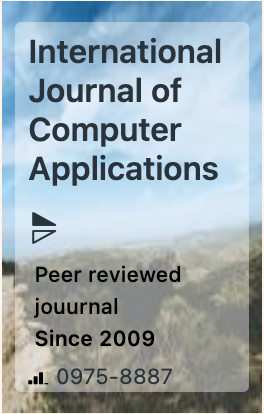The week's pick
Random Articles
Reseach Article
Integrated Agile Software Framework: The Role of Critical Success Factors in Completion of Agile Software Project
| International Journal of Computer Applications |
| Foundation of Computer Science (FCS), NY, USA |
| Volume 187 - Number 19 |
| Year of Publication: 2025 |
| Authors: Andrew J., Ramakrishnan M., Pal Pandi A. |
 10.5120/ijca2025925269
10.5120/ijca2025925269
|
Andrew J., Ramakrishnan M., Pal Pandi A. . Integrated Agile Software Framework: The Role of Critical Success Factors in Completion of Agile Software Project. International Journal of Computer Applications. 187, 19 ( Jul 2025), 12-21. DOI=10.5120/ijca2025925269
Abstract
In the present day dynamic business environment, Agile Software could be the only savior for the organizations to face the ever changing business challenges and the dynamic complex requirements of customers. Agile Framework being the light weighted, it never expected complicated processes. The people’s participation is very much considered in the agile framework development. Therefore, Critical Success Factors have occupied the key position and been considered to be foremost important in the agile software development process (ASDP) project. In accordance with the above requirements, ten CSFs have been identified and selected for this study. In order to investigate the presence of agility in the CSFs, the software developers were taken as samples and responses were obtained from them through the self structured and tested questionnaire. The data thus obtained were fitted to “t” and One Way ANOVA tests to understand the significant presence of agility with the selected CSFs and its influence over the Agile Software Development Project (ASDP). The results of the analysis clearly indicated the positive and significant association between the ASDP and the Critical Success Factors through their contribution of agility in the ASDP.
References
- Abrahamsson, P., Salo, O., Ronkainen, J and Warsta, J. (2002), “Agile Software Development methods: Review and analysis”, VTT Publications 478, p 107.
- Agarwal, U.A. (2014), “Examining the impact of social exchange relationships on innovative work behavior: role of work engagement,” Team Performance Management, 20, 102-120.
- Alkraiji, A.I., Jayawickrama, U., Olan, F., Asaduzzaman, M., Subasinghage, M and Callage, S. (2022), “The perspective of national ERP vendors in achieving ERP project success in government organizations case of Saudi Arabia”, Enterprise Information Systems, 16(1), 71-104.
- Bogopa, Ephraim and Marnewick, Carl, (2022), “Critical success factors in software development projects”, South African Computer Journal (SACJ), 34(1), 1-34.
- Chen, Y.S and Huang, S.Y. (2016), “A conservation of resources view of personal engagement in the development of innovative behavior and work family conflict,” Journal of Organizational Change Management, 29, 1030-1040.
- Brosseau, Daniel., Sherina Ebrahim., Christopher Handscomb and Shail Thaker. (2019) “The Journey to an agile organization”, McLomsey & Company, p1-10.
- Chow, T and Cao, D.B. (2008), “A survey study of critical success factors in agile software projects”, The Journal of Systems and Software, 81, 961-971.
- Elgamal, M. (2018), “Dynamic organizational capabilities: the joint effect of agility, resilience and empowerment”, Journal of Human Resource Management, 6(2), 44-49.
- Emam, A.S., Jais, J.B., and Tabash, M.I. (2019), “The role of tribalism as mediator between employee empowerment and organizational commitment in Yemeni Islamic banking sector”, Management & Marketing, 14(1), 130-149.
- Farahani, H.A., and Salimi, F (2015), “The Study of Relationship between Employees‟ Empowerment and Organizational Agility: A Case Study in Azarab Industrial Company”, European Online Journal of Natural and Social Sciences: Proceeding, 4(1), 1067-1075.
- Gorgievski,M.J.,Moriano,J.A.,andBakker,A.B.(2014), “Relating work engagement and workaholism to entrepreneurial performance,” Journal of Management Psychology, 29, 106-121.
- Hansen, Stefan.(2021),“The Challenge of Continuous change”, CXO Magazine, Q2,2021,Issue3-Agility in the age of Distruption, 1-9.
- Highsmith,J.(2002),AgileSoftwareDevelopmentEcosystems,Boston,MA.,Addison-Wesley.
- Horney, Nick., Pasmore, Bill., ad O ‟Shea, Tom. (2010), Leadership Agility: A Business Imperative for a VUCA World”, People & Strategy, 33(4), 31-38.
- Jeyathilagar, A., Ramakrishnan, M. and Ammavasai, P.P. (2025) ‘A conceptual model of integrated agile methodology in software development process’, Int. J. Enterprise Network Management, Vol. X, No. Y, pp.xxx–xxx (Forthcoming Article - In Print).
- Jeong, H and Sung, S. (2018), “The effect of learning agility on organizational citizenship behavior: focused on mediating effects of work engagement”, Journal of Lifelong Educational Human Resource Development, 14, 139-173.
- Joiner, Bill, (2009), Creating a Culture of Agile Leaders: A Developmental Approach”, People & Strategy, 32(4), 27-35.
- Kim,W. and Park, J.(2017),“Examining structural relationship between work engagement, organizational procedural justice, knowledge sharing, and innovative work behavior for sustainable organization,” Sustainability, 9, 205.
- Kocygit, Yesin and Akkaya, Biilent (2020), “The Role of Organizational Flexibility in Organizational Agility: A Research on SMEs,” Business Management and Strategy, 11(1), 110-123.
- Meyer, Pamela. (2021), “Leading the Agility Shift: slowing down to go fast”, CXO Magazine, Q2, 2021, Issue 2, 10-13.
- Misra, S.C., Kumar, V and Kumar, U. (2009), “Identifying some important success factors in adopting agile software development practices,” The Journal of Systems and Software, 82, 1869-1890.
- Salahat, Mahmoud Ali. (2021), “Employee Empowerment, Knowledge Management and Decision-making Agility; Mediating Role of Extra-role Performance”, International Journal of Academic Research in Business & Social Sciences, 22, (7), 96-977.
- Saputra, N. (2018), “Does learning culture impact directly or indirectly on work engagement in the Indonesian Oil Palm industry”, International Journal of Engineering Technology Innovation, 7, 561-566.
- Saputra, N., Abdinagoro, S.B., and Kuncoro, E.A. (2018), “The mediating role of learning agility and the relationship between work engagement and learning culture”, Pertanika Journal of Social Science and Humanity, 26, 117-130.
- Stankovic, Dragan., Nikolic, Vesna., Djordjevic, Miodrag and Cao, Dac-Buu. (2013), “A survey study of critical success factors in agile software projects in former Yugoslavia IT companies”, The Journal of Systems and Software, 86, 1663-1678.
- Tripathi, Vishvadeep and Goyal, Arvind Kumar, (2014), “Critical Success Factors for Agile Methodology Adaptation in Software Development Organizations”, International Journal of Computer Science and Mobile Computing, 3(4), 219-224.
- Yaghoubi, Nour-Mohammad and Dahmardeh, Mahboubeh Rahat., (2011), Knowledge Management: critical success factor in organizational agility”, American Journal of Social and Management Sciences, 272-277.
Index Terms
Keywords

